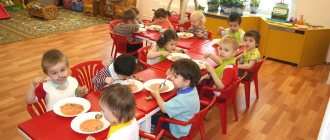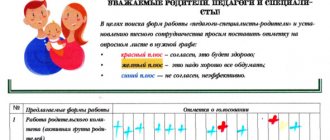Organization of a walk. Themed walks with preschoolers. article on the topic
Organization of a walk. Themed walks with preschoolers.
In the educational process, an important element in the daily routine is walking with children. The main task of the teacher when conducting walks is to provide active, meaningful, varied and interesting activities for children.
Traditionally, a walk includes such components as organizing children’s observations of natural phenomena (flora and fauna, inanimate nature); various games; work activity; sports exercises and independent activities of children according to their choice and interests. In this case, it is necessary to provide for a uniform alternation of calm and motor activity, distribution of physical activity during the entire walk.
To ensure that walks are varied and interesting for children, educators plan their content daily, including both the educational component and the children’s independent activities. Independent and joint activities with peers presuppose the availability of a variety of playing materials and equipment, the creation of various flexible subject-based play tools in the kindergarten area.
When planning a walk, the teacher must take into account many factors: weather conditions, the age of the children and their cognitive interests, available material, the topic of the previous lesson. It is necessary to provide for the possibility of a healing effect not only physically, but also mentally. For a child’s body, a properly organized walk can be the most accessible means of hardening.
The basic requirements that must be observed when organizing walks are defined in the relevant regulatory documents.
The joint activity of an adult with children during a walk is especially pronounced, since it is here that the child closely communicates with the teacher in all types of activities.
For a child, the educational process makes sense if it is built in the logic of activity. Therefore, the educational component of a walk is always connected with any type of children’s activity (play, communication, work, motor, cognitive-research, musical-art, productive) without its strict regulation.
It is clear that the leading play activity, through which the child learns about the world and organically develops, has a special role during a walk. Game forms of education can be in an individual, subgroup or frontal form of organizing work with students. Motor activity during a walk is combined with play, but at the same time the teacher is obliged to regulate the load by monitoring the condition of the children.
Modern requirements for updating the educational process suggest making walks as diverse as possible in content and organization.
In the methodological literature and individual regulatory documents, one can find confirmation that in addition to the traditional structure of walks with children that have developed over the years, thematic walks can be held, built on the principle of dominance of the type of children's activity or that are a continuation of the theme of the day in the educational process.
The authors of the guide “Themed Walks in Kindergarten” offer five types of themed walks:
walks and hikes;
entertaining walks with a character;
walk-events;
sports walks;
walks are labor actions.
Hiking is an organized type of activity, during which health-improving tasks are solved, motor skills and physical qualities of children are improved, their cognitive needs are satisfied, and love and aesthetic attitude towards nature are fostered. They should be carried out with children of older preschool age. The optimal number of such walks is 2-3 per year. We believe that if these walks are carried out frequently, they will lose their attractiveness and children’s interest in them will decrease.
Entertaining walks with the character are aimed at emotional and psychological relief for children, creating a positive emotional background, and satisfying children’s needs for physical activity. The forms of their organization can be diverse and variable, since they depend not only on the goals and objectives set, but also on the thematic focus and semantic richness.
Walking with a character is good for motivating children for a certain type of activity; the character helps to interest all the children in the group, attract them to joint play activities, observation, and work.
Walk-events are dedicated to a specific theme (Cosmonautics Day, Defender of the Fatherland Day, Victory Day, City Day, Knowledge Day, etc.) or an event that occurred in kindergarten (a new play complex was brought and installed, sports equipment was updated, sand was updated in the sandboxes, etc. .).
An event walk (thematic walk) helps the teacher once again draw children’s attention to an important event, clarify their knowledge and perception of a certain topic.
Sports walks are aimed at improving health, preventing fatigue, physical and mental development, and optimizing the physical activity of children. In sports walks, various types of children's activities are united by a sports theme.
When properly organized, these walks have a hardening effect on the body in natural conditions. They help increase the level of physical fitness of preschool children. The emphasis in such walks is on the formation of physical qualities, nurturing interest in sports and a healthy lifestyle.
These walks promote mental, moral, aesthetic education and develop the curiosity of preschoolers.
In walks and labor actions, labor assignments for children predominate, including them in forms of work that are different in organization in accordance with the season and weather conditions.
On walks associated with work activities, children develop an understanding that work in nature is not a game or entertainment, but a serious activity. The teacher brings them to an understanding of the need for such work, fosters a desire to participate in the work of caring for plants, feeding birds, and cleaning the area (raking snow, cleaning the veranda from sand and leaves).
On such walks, children learn to work in a team, together. The result of labor is the result of the joint work of everyone.
Bibliography:
- K.Yu. Belaya, E.A. Karalashvili, L.I. Pavlova and others. Themed walks in kindergarten. M.: Perspective, 2013
MAGAZINE Preschooler.RF
"Use of thematic walks in working with children of senior preschool age."Boyko Natalia Anatolyevna MBDOU "Snow White" Teacher of the speech therapy group City of Noyabrsk, Tyumen region Yamalo-Nenets Autonomous Okrug
I consider walks one of the most important organized types of motor activity in my work, during which I solve not only health-improving tasks, improve motor skills and physical qualities of children, but also cultivate a love and aesthetic attitude towards nature, satisfy their cognitive needs
I conduct walks with the following purposes:
- promote resistance to adverse environmental influences, especially colds, increase the stamina of the child’s body
- develop mobility, agility, courage, speed, endurance, strengthen the muscular system, increase vitality
- expand your understanding of the world around you, develop your powers of observation
- cultivate hard work
- cultivate love for your hometown
- to cultivate love and respect for the nature of our region
- develop mental processes and speech of children.
I give a special role to observations during the educational process during a walk. Observation in pedagogical work has been recognized since ancient times, since in the process of observation, observation, thinking operations (analysis, synthesis, generalization, classification) develop, and speech develops, which is so necessary for children in the correctional group.
Observations play a big role in the all-round development of the child:
- enrich children’s consciousness with new knowledge, help them gradually understand the objective world around them
- figurative representations accumulate, which provide reliable material for the formation of concepts
- provide material for determining similarities and differences, give rise to concepts, judgments and inferences.
When working with children, I plan the following observations:
- observation of living objects (birds, deciduous and coniferous trees, flowers, shrubs, etc.);
- observations of inanimate objects (sun, weather, clouds, wind, snow, snow depth, blizzard, drifting snow, snowfall, length of day, etc.);
- observation of the phenomena of the surrounding reality (the work of adults, skiers, passers-by, transport - snowplows, etc.).
In addition, throughout the entire walk I more than once clarify and consolidate the data obtained by the children not only during organized observations, but also in the process of their own observations and knowledge.
Children's acquaintance with the world around them most often begins with direct visual observation. The essence of observation lies in the ability of children to peer into objects and phenomena, to identify the essential and secondary in them, to notice changes occurring in the environment, and to establish their causes.
The pedagogical process aimed at forming observation ensures the gradual accumulation and systematization of knowledge, as well as the formation of an increasingly conscious attitude of the observer to the observed. In the process of observation, an invaluable property of the human personality is born and strengthened - observation.
Observation of objects and natural phenomena is impossible without movements, which means that the use of this method when getting acquainted with nature contributes to the physical development of the child. Observations contribute to the development of organization, independence, discipline, and initiative in the child. The direct perception of natural objects and their diversity have an emotional impact on children, causing them joy, surprise, and delight.
In order for observations to play their positive role, from early childhood I develop the ability to observe in a child: not just to look at an object, but to see it in such a way that I can then clearly imagine this image in all its details. I develop the ability to see through long, painstaking work.
Observations will not be effective without guidance. Guiding observations gives me the opportunity to teach preschoolers to focus on the most significant signs of observed phenomena and to discover relationships in nature. Observation requires serious preparation, endurance, and patience from both me and the child. I constantly teach children to look for and find new things in what they have already seen and known, and to not be indifferent.
I definitely use artistic expression, singing songs (if seasonal conditions allow), round dances, outdoor games, didactic exercises, as well as folklore material.
In order to increase children’s interest in observations, consolidate acquired skills and abilities, and enrich their vocabulary, I decided to use walks involving fairy-tale characters, which have already brought positive results: interest in observations increased, speech became richer, saturated with adjectives, antonyms, synonyms, and comparisons.
I conduct themed walks on Mondays, with the obligatory presence of a fairy-tale character (I dress up and play a role), who conducts conversations, observations, outdoor games, speech games, etc. throughout the walk. Now I conduct themed walks with the aim of attracting children to the origins of Russian folk culture, developing the artistic and speech activity of children based on oral folk art. Such walks help me relieve the psychological stress of children by creating conditions for easier adaptation to the conditions of kindergarten after the weekend.
I bring to your attention a promising plan for themed walks with older children.
Long-term plan for themed walks
(senior compensatory group for children with disabilities - severe speech impairment)
| Next > |
“Organization and methodology for conducting walks in an early age group in kindergarten”
“Organization and methodology for conducting walks in an early age group in kindergarten”
The importance of walking in the development of preschool children. Children's stay in the fresh air is of great importance for the physical development of a preschooler. Walking is the first and most accessible means of hardening a child’s body. It helps to increase its endurance and resistance to adverse environmental influences, especially colds. During the walk, children play and move a lot. Children become more active, dexterous, courageous, and resilient. They develop motor skills and abilities, and their vitality increases. A walk promotes mental development, as children gain a lot of new impressions and knowledge about the world around them. Requirements for the duration of the walk. Duration of outdoor walks. The daily routine of the kindergarten provides for a daily daytime walk after classes and an evening walk after afternoon tea. The time allotted for walking must be strictly observed. Its total duration is 4 - 4.5 hours. — To achieve a healing effect in the summer, the daily routine provides for children to spend maximum time in the fresh air with breaks for meals and sleep. — In winter, outdoor walks are carried out 2 times a day: in the first half of the day - before lunch, in the second half of the day - before the children go home. Winter walks in kindergarten for children under 4 years old are held at temperatures down to -15°C. Preparing for a walk. Before going out for a walk, the teacher organizes hygiene procedures with the children: cleaning the nose, visiting the toilet. The teacher must teach children to dress and undress independently and in a certain sequence. First, they all put on warm pants, shoes, then a scarf, coat, hat, scarf and mittens. When returning from a walk, undress in the reverse order. The nanny helps dress the kids, but gives them the opportunity to do what they can on their own. When children develop the skills of dressing and undressing, they will do it quickly and carefully; the teacher only helps them in individual cases (fasten a button, tie a scarf, etc.). We need to teach kids to help each other and not forget to thank each other for the service rendered. In order for dressing and undressing skills to develop faster, parents should provide their children with more independence at home. In the summer, after children return from a walk, it is necessary to organize a hygiene procedure - washing their feet. Requirements for children's clothing: - at any time of the year, clothing and shoes must be appropriate for the current weather and should not contribute to overheating or hypothermia of children; Properly organized and thoughtful walks help to achieve the goals of the comprehensive development of children. Observation. A large part of the walks is devoted to observing natural phenomena and social life. At a younger age, observations should take no more than 7-10 minutes and be bright and interesting. They should be carried out daily, but each time children should be offered different objects to consider. Objects of observation can be: Wildlife: plants and animals; Inanimate nature: seasonal changes and various natural phenomena (rain, snow, flowing streams); Adult labor. Observations of the work of adults (janitor, driver, builder, etc.) are organized 1-2 times a quarter. Outdoor games. The leading place during the walk is given to games, mainly active ones. They develop basic movements and relieve mental stress from exercise. The choice of game depends on the time of year, weather, air temperature. On cold days, it is advisable to start your walk with games of greater mobility associated with running, throwing, and jumping. Fun and exciting games help children cope better with cold weather. In damp, rainy weather (especially in spring and autumn), sedentary games that do not require a lot of space should be organized. At a younger age, games with text (imitation of the teacher’s actions) are recommended. During walks, the teacher conducts individual work with children: for some he organizes a game with a ball, throwing at a target, for others - a balance exercise. About half an hour before the end of the walk, the teacher organizes quiet games. Then the children collect toys and equipment. Before entering the room, they wipe their feet. Children undress quietly, without noise, carefully fold and put things in lockers. They change their shoes, put their suit and hair in order and go to the group. Features of the organization of physical activity in winter: - in the cold season, the teacher needs to ensure that children breathe through their nose. Various didactic exercises are a way to stimulate children's activity. They are carried out several times during one walk. A didactic exercise can be offered to children at the beginning, at the end, or can be woven into the course of observation, for example, “Bring a yellow leaf,” “Find a tree by leaf,” “Find a tree or shrub by description,” etc. They are carried out with the whole group or with part of it. During walks, work is also done to develop the child’s speech: learning a nursery rhyme or a short poem, reinforcing a difficult sound to pronounce, etc. The teacher can recall with the children the words and melody of a song that they learned in a music lesson. Labor activity of children at the site. Work activity while walking is of great educational importance. The teacher shows the children of the younger group houses, transport, and pedestrians. Safety requirements when organizing walks in the kindergarten area. If the wind increases to unacceptable levels or weather conditions worsen (rain, snowstorm, etc.) during a walk, the teacher must immediately bring the children indoors. During the walk, the teacher makes sure that the children do not leave the kindergarten grounds. During the walk, the teacher should teach safe behavior skills and rules for safe handling of various objects. It is prohibited: Leaving children alone, unattended by employees of the Institution; Use sharp, piercing, cutting objects, or broken toys in children's games. The teacher must immediately notify the supervisor and parents of any accident involving a child, and, if necessary, involve medical personnel to provide first aid. If necessary, arrange for the child to be taken to the emergency department. A walk is a mandatory element of the daily routine. The main task of the teacher’s pedagogical work during a walk is to provide active, meaningful, varied and interesting activities for children. At any time of the year, during a walk, each teacher is obliged to monitor the well-being and thermal state of the children. In the cold season, avoid hypothermia, and in the warm season, avoid overheating. During the summer period, the teacher is obliged to observe the drinking regime during walks.



